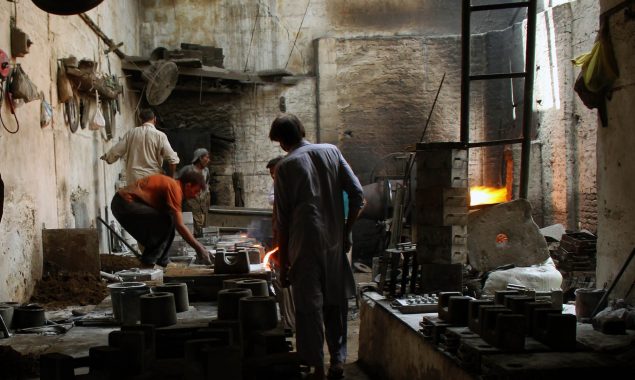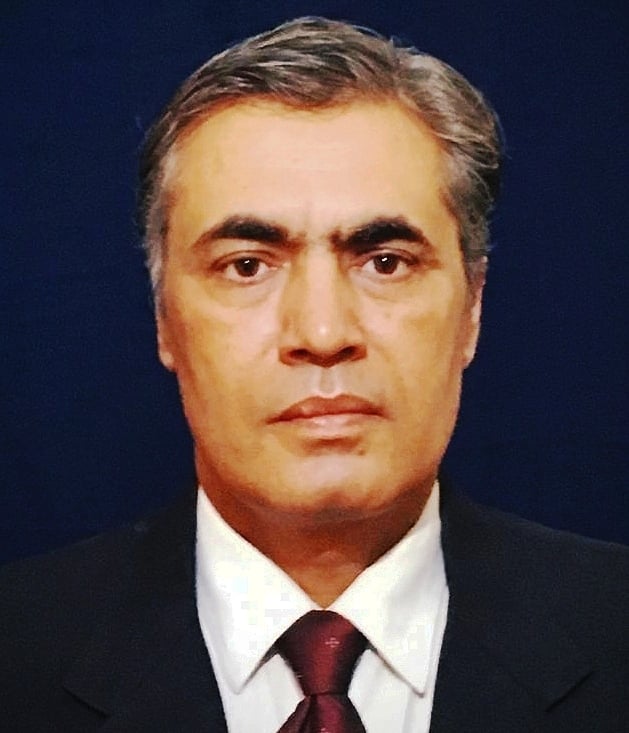
The large-scale manufacturing posted a 14.9 per cent increase in FY21. Photo: Athar Khan
KARACHI: The State Bank of Pakistan (SBP) has projected the real GDP growth at 4 per cent to 5 per cent for the current fiscal year, as per the actual target set for the fiscal year. However, the current account deficit has been projected at up to 3 per cent of the GDP as against the actual estimate of 0.7 per cent for the fiscal year 2021/22.
In its Annual Report 2020/21 on the “State of Pakistan’s Economy” issued on Wednesday, the SBP said the average Consumer Price Index (CPI) would be around 7 per cent to 9 per cent.
The remittance inflows and exports have been projected at $32.5 billion and $27.5 billion, respectively, during the current fiscal year; however, the import bill projection has gone up to $63.5 billion as against the actual estimate of $55.3 billion.
Similarly, the fiscal deficit has been estimated to be in the range of 6.3 per cent and 7.3 per cent for the current fiscal year against the target of 6.3 per cent.
According to the report, Pakistan’ economy rebounded during FY21, with the real GDP growth rising to 3.9 per cent. Importantly, this expansion in the economic activity was accompanied by a 10-year low current account balance that contributed to a significant buildup in foreign exchange reserves.
The fiscal deficit also edged down despite the Covid-related spending, leading to an improvement in the public debt-to-GDP ratio, unlike the experience of most countries across the world.
The headline CPI inflation also eased during the year, mainly due to relatively stable prices of non-food and non-energy items. However, the overall price levels, especially of food items, remained high, owing to supply-side challenges.
The report notes that the economic turnaround was facilitated by exceptional management of the Covid health pandemic, as well as a prompt and targeted monetary and fiscal response to counter its impact on the economic growth and livelihoods.
The SBP’s liquidity support amounted to around 5 per cent of GDP by the end of FY21, featuring a combination of policy rate cuts, as well as several targeted and time-bound measures, such as the Temporary Economic Refinance Facility (TERF) for the promotion of new investment, Rozgar payroll financing scheme to prevent layoffs, the refinance facility to combat Covid and to provide concessional financing to construct hospitals and facilities, and temporary loan deferments and restructurings to provide temporary liquidity relief to small and big businesses, as well as individual borrowers.
Other policy initiatives to bolster economic activity included: promoting digitalisation in the economy; temporarily relaxing concessionary credit and realisation and settlement of export proceeds and trade loans; incentivising housing and construction finance and promoting provision of mortgages for the low-income households; and providing forward guidance for the near-term monetary policy stance to facilitate economic decision-making, amid the Covid-related uncertainty.
Similarly, the government provided targeted fiscal support of around 2 per cent of GDP through an economic stimulus package, which covered over 15 million families through emergency cash transfers.
In addition, the government introduced various incentives to prop up the activities in agriculture, manufacturing and export sectors during FY21.
The report highlights that a broad-based recovery was recorded in the real GDP growth. Led by the favourable supply and demand dynamics, as well as a low base effect from the Covid-led contraction in FY20, the large-scale manufacturing posted a 14.9 per cent increase in FY21. Though the growth in agriculture was slightly lower than in FY20, the production of wheat, rice and maize rose to historic levels.
The cumulative increase in the production of these crops offset the decline in cotton production. The improvement in the commodity-producing sectors and a surge in imports led to a sharp recovery in the wholesale and trade services in FY21.
The recovery in the economic activities was also enabled by a significant expansion in credit offtake by the private sector. The SBP’s concessionary refinance schemes, such as TERF and the Long-Term Financing Facility, played a major role in driving the fixed investment loans during the year.
The report also notes that the economic rebound was achieved without worsening of the macroeconomic imbalances, as the overall policy mix was still prudent.
The current account deficit reduced substantially, amid record high workers’ remittances and export receipts, and contributed to the $5.2 billion increase in the SBP’s forex reserves during the year.
The country also retained access to sizeable external financing, with inflows received from the International Monetary Fund (IMF) and other multilateral and bilateral creditors; the issuance of Eurobonds after a long hiatus; and deposits and investments from non-resident Pakistanis via the Roshan Digital Accounts.
The report points out that the recovery in exports was driven by the continued adherence to the market-based exchange rate system; provision of subsidised inputs; lower duties on imported raw materials; and the fast-tracking of the general sales tax (GST) refunds. Also, the impact of some deflected orders from competitors, as Pakistan emerged faster from the Covid shock helped boost textile exports.
The higher exports partially offset a significant rise in import payments, which surged, amid the upswing in the economic activity; supply-side challenges in wheat, sugar and cotton; and elevated international commodity prices.
These pressures became more prominent towards the end of the year, leading to a 3 per cent depreciation of the rupee against the dollar during the fourth quarter; during July-March, the rupee had appreciated 10 per cent, mainly due to the accumulated current account surpluses.
Meanwhile, the fiscal deficit reduced to 7.1 per cent of GDP from 8.1 per cent in FY20. Restrained non-interest current expenditures allowed for undertaking spending on social safety nets, the economic stimulus package and provision of targeted support to various sectors of the economy.
The development spending also recovered slightly after consistently declining over the last three years; however, the government had to make payments of power sector subsidies to partially clear the circular debt.
On the revenue side, the Federal Board of revenue’s (FBR) tax collection improved sharply in the wake of the economic rebound, surge in imports and the efforts to streamline the tax administration.
With the containment of the twin deficits and the rupee appreciation, the public debt-to-GDP ratio declined to 83.5 per cent in FY21.
Further, the average headline CPI inflation fell to 8.9 per cent in FY21, within the SBP’s forecast range of 7 per cent to 9 per cent. The resurgence in domestic demand did not translate into inflationary pressures, amid the presence of some spare capacity in the economy.
However, inflation remained volatile during the year, because of the impact of the increase in fuel prices and power tariffs. Moreover, the food group emerged as the largest contributor to inflation during FY21, primarily because of supply-side challenges in the non-perishable items.
The report maintains that addressing deep-rooted structural impediments is crucial for sustaining and improving the current growth momentum.
These impediments include consistent decline in the yield of important crops, especially cotton; insufficient export coverage of imports, low and declining productivity of labour, stagnant tax-to-GDP ratio; anemic investment-to-GDP ratio; and the rising fiscal burden of the power sector.
In this context, tapping the potential of the Special Economic Zones (SEZ) can play an important role. The SEZs are already gaining prominence in Pakistan, given the focus of the second phase of the China-Pakistan Economic Corridor (CPEC) on enhancing business-to-business cooperation.
A Special Chapter in this report provides an overview of the SEZ landscape in the country and policy recommendations to ensure that the SEZs achieve their desired objective of stimulating investments in the country.
Read More News On
Catch all the Business News, Breaking News Event and Latest News Updates on The BOL News
Download The BOL News App to get the Daily News Update & Follow us on Google News.




